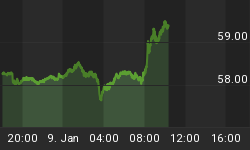Worst Week Since 2008 Financial Crisis

Below is a quick refresher course on the 2011 events that led to the "most volatile week in stocks since the 2008 financial crisis". From Wikipedia:
President Obama signed the Budget Control Act of 2011 into law on August 2, the date estimated by the department of the Treasury that the borrowing authority of the US would be exhausted. Four days later, on August 5, the credit-rating agency Standard & Poor's downgraded the credit rating of US government bond for the first time in the country's history. Markets around the world as well as the three major indexes in the US then experienced their most volatile week since the 2008 financial crisis with the Dow Jones Industrial Average plunging for 635 points (or 5.6%) in one day. Yields on US Treasuries, however, dropped as investors, anxious over the dismal prospects of the US economic future and the ongoing European sovereign-debt crisis, fled into the safety of US government bonds and bonds of other safe haven economies.
Traders Get Positioned Before Big Events
The market's pricing mechanism allows us to monitor the aggregate risk tolerance of all market participants. Last week we noted the markets carried a bullish profile into the Fed's non-tapering gala, meaning the market was properly positioned for what many termed as a "surprise" outcome.
Risk Profile 2011 vs. 2013
Were market participants concerned before the August 2011 plunge in stocks or did it come out of the blue? The 2011 chart of the S&P 500 below shows the markets were consolidating for seven months (orange box) before the U.S. credit rating was downgraded in August, meaning the markets were concerned well before the "surprise" came on the credit downgrade front. The blue, red, and green lines are moving averages that help filter out day-to-day volatility. The slopes of the moving averages before, during, and after the August 2011 waterfall decline show a market that was telegraphing concerns well before the big event (see lines A, B, and C below).

The current version of the same chart shows a market that has been rising over the past seven months, rather than consolidating (compare orange boxes). The slopes of the blue, red, and green moving averages look nothing like June-August 2011. The present day trend is much stronger, which reflects more confidence in the economy's longer-term outlook.

Friday's Developments

As of the market close Friday, there have been no major surprises out of Washington. From Bloomberg:
The U.S. Senate voted today to finance the government through Nov. 15 after removing language to choke off funding for the health care law. The bill now returns to the House, setting up a weekend of negotiating and brinkmanship that could continue until spending authority expires on Sept. 30. House Republicans are insisting that the short-term spending bill include limits on the health-care law's reach, a demand that Democrats say they won't accept. Congress must also reach a deal to avoid hitting the limit on the government's ability to borrow.
Investment Implications - Some Cracks
Our market model became more bullish weeks ago. As noted below, the markets remain well above those early September levels.

The market's pricing mechanism has shown enough concern about uncertainty on the budget to call for a reduction in our exposure to risk. We reduced our stake in the S&P 500 ETF (SPY) before the close Friday. An incremental risk-reduction move was prudent, but a net long stake remains warranted due to the somewhat limited magnitude of the deterioration. For example, conservative bonds have not shown enough interest to significantly alter the weekly supply and demand scoreboard. The demand for bonds relative to stocks is well behind the levels seen in August 2011. The green arrow below shows bonds were trending in a bullish manner relative to stocks for five months before the "credit event" in August 2011. In 2013, bonds remain in a downtrend vs. stocks, which shows present day concerns about future political and economic events are more subdued than they were in 2011.

The slopes of the green and red arrows above show the clear differences in the market's tolerance for risk between 2011 and 2013.
Tech, Small Caps, and Europe Outperform
Our ETF screening system uncovered small caps and technology stocks long ago. On September 7, we highlighted these two sectors:
Our market model did see incremental improvement during the week. Consequently, we increased our exposure to broad market positions (SPY), taking an incremental step back toward risk. We have held small caps (IJR) and technology (QQQ) through the recent pullback.
How have small caps and technology performed since September 7? Both have continued to beat the S&P 500.

Our recent stake in foreign stocks (EFA) also had a good week relative to the S&P 500, which gives us a little more room for patience as the soap opera in D.C. continues to run on what feels like an endless loop.

This weekend's video will cover the observable changes that occurred in the market's profile this week, which formed the basis for our allocation changes this week.















